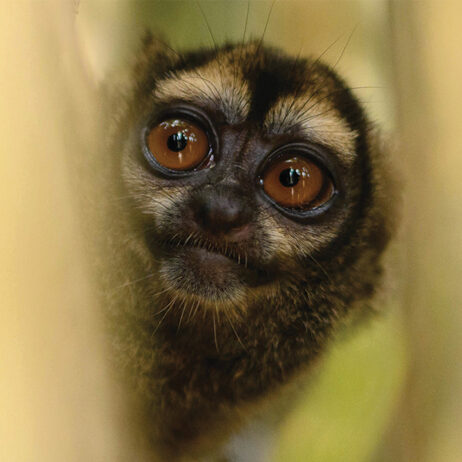
Richard Cuthbert, WLT’s Director of Conservation, leads a session on the role of privately protected areas in global conservation. Credit: WLT
From 9–15 October, World Land Trust’s (WLT’s) Conservation Team joined thousands of conservationists, researchers, Indigenous leaders, and policy experts for the 2025 IUCN World Conservation Congress in Abu Dhabi. This year’s Congress – the largest global gathering for nature – set out a collective vision for the next 20 years of conservation, with a strong emphasis on meaningful inclusion and cooperation across sectors.
Over 20 of WLT’s conservation partners were present, offering a rare opportunity for face-to-face connection and strategic discussion. We caught up with WLT’s Charlotte Beckham (Senior Conservation Programmes Manager) and Mary McEvoy (Carbon Programme Manager) to hear their reflections on the week.
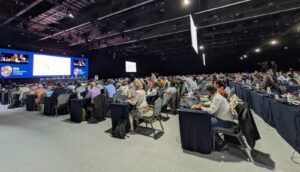
During the Congress, members – including WLT – voted on the IUCN’s 20-year strategy: a vision of global nature conservation for the next 20 years. Credit: WLT
WLT: What were the main themes running through this year’s Congress?
Mary: This Congress had a real emphasis on Indigenous Peoples and local communities – not just as participants but as leaders in conservation. The sessions gave space for them to express their perspectives in their own ways.
One that stood out began with a Māori woman performing songs and animal sounds representing the forests of New Zealand. It was incredibly powerful and a reminder of how conservation and culture are intertwined.
There was also a strong effort to make sure young people are meaningfully included, again not as a token presence but with genuine space to share their perspectives.
Charlotte: I completely agree. That theme of meaningful inclusion ran throughout.
Another key theme was ensuring protected areas are truly effective, not just existing on paper. There was a lot of discussion about improving management and governance to make sure these areas deliver real conservation outcomes.
As part of this, we co-hosted a session on the role of privately protected areas in global conservation. Many privately protected areas are delivering vital conservation outcomes but are not generally recorded at the international level, for example in the 30 x 30 target: an initiative to designate 30% of Earth’s land and ocean area as protected areas by 2030. This was a fantastic opportunity to highlight the significant contribution of private protection towards wider conservation aims.
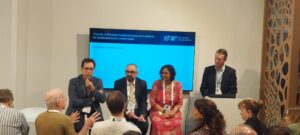
Richard Cuthbert hosts a session with WLT’s partners on the important contribution of private protected areas towards wider conservation aims. Credit: WLT
WLT: From representing WLT in the exhibition hall, what kind of conversations stood out?
Mary: I think we were both really impressed by the quality of the projects and prospective partners who came to talk to us. People are doing such amazing work – often in very difficult circumstances. The inspiration in the room was palpable.
Charlotte: And every conversation felt worthwhile. Each was with someone interesting, with a clear overlap or opportunity to collaborate. There was this real attitude of “Let’s do something practical and positive.”
Previous conferences have sometimes felt slightly split between hands-on conservation and the more government-focused aspects, but this one felt more integrated and holistic.

A whirlwind of conversations: WLT’s stand provided a fantastic springboard for Mary and Charlotte to hear from prospective partners, co-funders, and existing supporters. Credit: WLT
WLT: How were the conversations with WLT’s existing partners?
Charlotte: For me, it was a chance to catch up with specific partners about ongoing projects and challenges – conversations that can be difficult to have online. We also had the opportunity to meet co-funders and collaborating partners like Rainforest Trust, American Bird Conservancy and IUCN Netherlands. Having the time and space to discuss ideas and how best we can utilise our combined resources to have a greater impact on conservation is invaluable.
Mary: I had a lot of discussions focused on carbon methodologies and project feasibility. One partner we’re working with is in the process of developing a carbon project, and it was really helpful to discuss that face to face. That conversation may well not have happened online, so it is really invaluable to be together in person.
I also focused on finance-related sessions, exploring how conservationists can better connect with the financial world. It’s a very different language and pace, but crucial if we’re to access funding for biodiversity and climate goals.
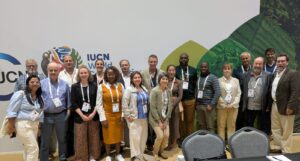
The Congress was a fantastic opportunity to bring together and hear from over 20 of WLT’s conservation partners. Credit: WLT
WLT: Were there any unexpected interactions?
Mary: Yes! We had several individual donors visit our stand – people who already support WLT and wanted to say hello. It felt like an extended family. Their positivity and encouragement were really uplifting.
WLT: What do you feel were the most important outcomes for WLT?
Charlotte: Being able to gather so many partners in one place was a huge benefit. It’s difficult and costly to organise a dedicated partner symposium, so this was a chance to discuss our conservation strategy together in person. For this, we hosted a session where we presented our strategy and invited feedback from our partners. This was incredibly helpful.
Networking was also key — hearing what others are doing globally helps us understand where WLT fits within the wider conservation landscape, and it’s reassuring to see that we’re aligned with current global thinking.
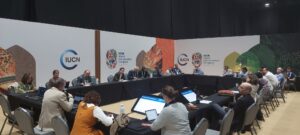
A session led by Richard Cuthbert presenting WLT’s conservation strategy to our partners and amending this according to their feedback. Credit: WLT
Mary: It was also invaluable to be surrounded by our partners – they’re an amazing bunch. Many of them face similar challenges, so being able to say, “You two should talk about this shared issue,” is really powerful. It helps make the partnership network feel more real and connected.
And it’s a small world! At one point, someone came to pitch a project in Madagascar, and it turned out he’d gone to school with our partner Mamy Razafitsalama from Planet Madagascar. Those moments really bring home how interconnected this community is.
WLT: During the event, WLT’s partners were elected to IUCN Council and Commission positions. Can you tell us more about this?
Charlotte: Yes, so this was an excellent example of the influential role of WLT’s partners in international conservation. Vivek Menon from our partner Wildlife Trust of India (WTI) was voted as the head of the Species Survival Commission, succeeding Dr. Jon Paul Rodríguez from our partner Asociación Civil Provita (Provita), who has led in this role for the past nine years.
In addition, Ruben Khachatryan from Foundation for the Preservation of Wildlife and Cultural Assets (FPWC) was elected as one of three Regional Councillors for the East Europe, North, and Central Asia region. Madhu Rao, a member of WLT’s Conservation Advisory Panel (CAP), also continues in her role as Chair of the World Commission on Protected Areas (WCPA).
WLT: Do you have any final reflections?
Charlotte: The Congress reminded us that conservation is global but deeply personal. Seeing partners, co-funders, and peers all in one place – sharing ideas, challenges, and optimism – was incredibly motivating.
Mary: Exactly. It’s about connection. We left feeling part of a much larger movement — and proud that WLT and our partners are helping lead the way.
Join this movement of change. Donate today and support our work to protect the world’s most threatened species and habitats.

